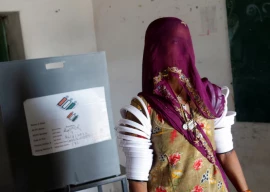
The post-2014 scenario is centered on Afghanistan and the American drawdown, as some want to call it. I still think, it will be a withdrawal; in effect, if not physical. Though, the physical, too, will follow soon when the futility of it all becomes obvious. For the moment, though, let things be, in any number under the Bilateral Security Agreement (BSA). That will only help save the fracas of a debilitating bloodshed.
And if the Afghans can just be kept off the impending civil war long enough, just because Afghanistan will still not wholly belong to them because of a continuing American presence; and it will not be up for grabs as would be if the Americans were to leave lock, stock and barrel, they may just forget to brandish their weapons on each other, instead slipping into an ensuing order that may just become their default new normal — more pacifist, more civil.
This will be good for Pakistan and the region. Militancy may subside and terrorism may lose its centrality in how business is conducted in Afghanistan. Without doubt, it will need a decent helping hand by those around; and this is where India and Pakistan will become relevant to the Afghan issue, as they have been till date in an insidious and competitive proxy juxtaposition. South Asia, thus, is correctly placated; and Afghanistan for reasons known to it alone has decided to join this compact called Saarc to suck in all what Saarc had on offer. Mostly obnoxious, at the hands of its two principals: India and Pakistan.
Outside of what might ensue, were Afghanistan to slide further into an irrecoverable mess, there will remain the abiding and inherited schism of the Durand Line that even the Afghan Taliban, purportedly the friendlier of any disposition that has ruled Afghanistan, were reluctant to regularise with Pakistan. The line that divided British India and Afghanistan thus continues to be a sore between today’s Pakistan and Afghanistan, even if all else was smooth as silk between them. How a 350,000 military and paramilitary Afghan National Security Force will impact this conundrum is only a matter of interesting conjecture. The helpful presence of some up to 15,000 foreign troops (mainly US) will add some more to Afghan stridence, especially if on Karzai’s vehement insistence, the clause to ‘jointly fight Afghan enemies’ does find an entry into the proposed BSA .
On to the other front now; the eastern front, where historical enmity — calling it animosity takes the sheen away — has tied both India and Pakistan into a Gordion knot that even Alexander today will find difficult to untangle. Kashmir, Siachen, Sir Creek, water, terrorism and proxy vendettas, all conflate into one intractable characterisation that will leave even the most sought statesmen in South Asia hopelessly short of the miraculous potions to undo what the geographical divide of British India has bequeathed to its two successors. And then arrives the Prince of Gujarat and the BJP, Narendra Modi, to add to perceived complexities. But then who knows; the greatest promise for better days that India and Pakistan ever had was under the BJP’s Vajpayee ji.
The underlying root in these various formulations of dissonance remains a fuzzy territorial divide that the Brits left for South Asia to behold and reckon. This has given cause for intricate politics to muddle what lies at the core. To cut through these layers of intractability, if we could resolve Kashmir, all else should fall in place. Resolving Kashmir though, is a loaded proposition in an environment where symbols matter; and where national pride has greater value than peace and material well being. It helps to explain thus that a solution must of essence be ‘mutually acceptable’. If it seems like inching towards accepting the status quo, perhaps that is what it is. A territorial solution that does not entail additional cost in territory to any side is what will be of mutual interest and is more likely to work. It may, in the end, also be the final arbiter for South Asia to open its doors to what has been till now the forbidden land of simple, peaceful coexistence.
With the changes afoot in South Asia, and the greater likelihood of the current spate of strife subsiding as Afghanistan and Pakistan deal with the aftermath of a vicious tryst with militancy and terrorism, through a combination of dialogue, mopping operations and some introspective improvements of how these nations have worked within and without — this perhaps is now the moment for the region to think itself anew. Governments and societies need to resolve their distortions that become the trigger for such radicalism and militancy. Neighbours need to be helpful and not disruptive. Age-old territorial issues must not remain intractable and must find accommodation on all sides in mutually beneficial resolutions.
If nations have lived with the issues that have neither been resolved through wars, nor through dialogue, over decades and centuries, chances are those are irresolvable and must be so accepted. Which really means that beyond a given date in history, post-Bangladesh perhaps, what is, should be so accepted. If in the bargain, both India and Pakistan can give up claims on each other’s parts of Kashmir, that can be a swell beginning and real tectonic shift. We can then proceed to work together on how to organise Kashmir and its associated territories as unified sociocultural and territorial entities while remaining within the joint protectorate of both India and Pakistan. India can continue to retain its stated position on border issues with China on territories that are contiguous to India. Such a resolution will subsume irritations such as Siachen too. A similar approach towards a mutually beneficial final resolution can be found for Sir Creek, too. Both nations must equally benefit from the potential and increase complementarities, simply because confrontations is the wrong way to live and exist.
This simply might convince Afghanistan, too, to relent on the Durand Line, enabling border control mechanisms that can minimise transgressions and enable better control. Trade, travel, exchange of people and ideas, and innovation are then sure to follow. Now is the moment, while a new dawn awaits. This may then be the only game in town.
Published in The Express Tribune, December 14th, 2013.
Like Opinion & Editorial on Facebook, follow @ETOpEd on Twitter to receive all updates on all our daily pieces.
COMMENTS (24)
Comments are moderated and generally will be posted if they are on-topic and not abusive.
For more information, please see our Comments FAQ

















1714119118-0/image-(7)1714119118-0-270x192.webp)












1714024018-0/ModiLara-(1)1714024018-0-270x192.webp)









@Anjaan Agreed sir wish this region will educated and understand that...
@Jag Nathan: I tend to agree with Komal... Modi maybe a hawk... but realpolitik may need him to water down his approach towards neighbours... We may be in for surprises.. Who knows... After all it was Mr. Vajpayee the leader of "Hindu right-wing" BJP who extended his hand of friendship to Pakistan in 1999.
@Jag Nathan: All these assumptions about Modi playing a hard ball is just a speculation. He is just a Chief Minister and we have no clue how his foreign policy is going to be. No Indian leader will succeed with belligerent approach to relationship with neighbors. Let us hope he is smart enough to take the relationship forward.
@ Jag welcome to real world, the situation here is more complex than you put out of enimosity, we both - India and Pakistan is heading toward fight for survival, and this battle of survival we don't need more enemies than the problems knocking our doors already are tough and getting un-manageable - it's a battle of survival my friend not continuation of two nation theory
There are 23 resolutions on Kashmir, including one forbidding puppetIndia Kashmir assembly from acceding to India. Not Pakistan, but India shouid approach Un for any non-plebiscite solution of Kashmir dispute. India professes clasula rebus sic standibus, but does not ask Un to invoke it.
@ author" There are two games in town these days: what happens to South Asia post-2014; and what will become of India and Pakistan post the Indian elections of April 2014." Sir, A third game has already begun. A report in today's Dawn says that Iran has decided not to give the promised loan to Pakistan to build the Pakistan part of the IP pipeline. Air Marshal, with Pakistan's economy in such a bad shape, don't you think your country's leaders should start looking more inwards and try and right the wrongs. regards
For once, I agree with Mr. Chaudhry. Most of the time I felt his views are clouded by his defence background, but this one he thinks a little more clearly.
Kashmir as a geographic issue will not be settled through any kind of attrition as both India and Pakistan are capable of defending territories under their control.
Thus only logical outcome for geography dispute is to freeze it with status quo, with a clear GPS marked boundaries across the terrain.
India perhaps will continue to have a problem in Kashmir valley. But, that is left for India to settle with Kashmir Muslims, as India does not have a problem with Hindu & Buddhists who make up about 40% of the J&K state.
Perhaps India will move towards bifrucating J&K in to two states. Kashmir and Jammu&Laddakh, thus paving the way for some sort of autonomous status only for Kashmir Valley in the lines of Hong-Kong & macau which are under china. Thus Kashmiri muslims can have maximum autonomy while still being part of India, without violating Indian constitution.
@faizaan: Yes.. It should not be forgotten until it reaches 1 million.. keep it up
Author suggestion is reasonable and only viable solution of this Indo-Pak conundrum.
Aren't you forgetting something-more than 60,000 innocents dead in Kashmir, or should they be conveniently forgotten..
Inane, aimless and dry piece with nothing to add.....
"We can then proceed to work together on how to organise Kashmir and its associated territories as unified sociocultural and territorial entities while remaining within the joint protectorate of both India and Pakistan. " Joint protectorate of both India and Pakistan? Dream on!
Good to see white flag being waved. However, there is a catch. You have omitted the most crucial destabilizing factor of the region: the infrastructure of non state actors aka terrorists sponsored by PA. Until then unfortunately yours is still empty rhetoric.
We will not give up land of "Kashyap Rishi". If you guys want to give up POK go ahead and make it an independent nation.
Sir,When Modi will come to power Pakistan will not be able to speak on Indian kashmir ...on the contrary this man will speak more on POK and Gilgit baltistan...The biggest mistake that we have made is by making china part of this issue..we have generously donated china shakshgam valley which is part of kashmir......Gilgit is already becoming china's proxy..I hope evrything goes well after 2014 and coming days......hope et did not ban my comments... regards..
@ Author : ".. If in the bargain, both India and Pakistan can give up claims on each other’s parts of Kashmir,.." That is what India has been asking for all these years!
And no matter who is in power in Delhi (BJP / Congress or anyone else) - there will NEVER be a border re-draw in Kashmir or elsewhere. Indians have long moved on from their original demand of all of Kashmir; it is time Pakistan moves on too! Status quo is the ONLY solution - take it or leave it, your choice.